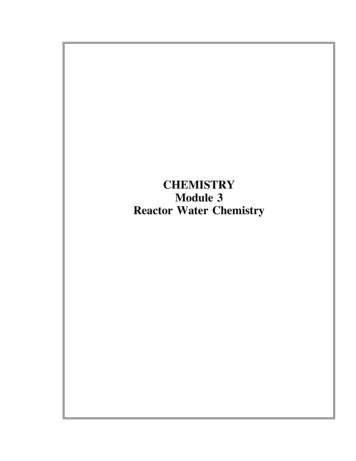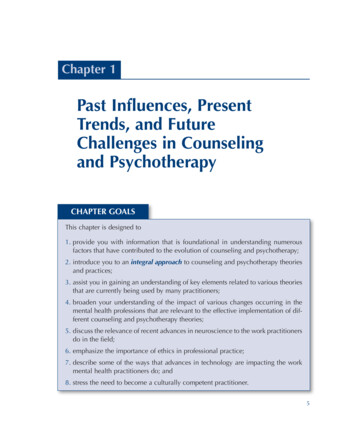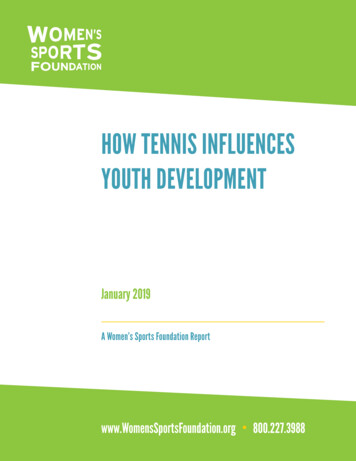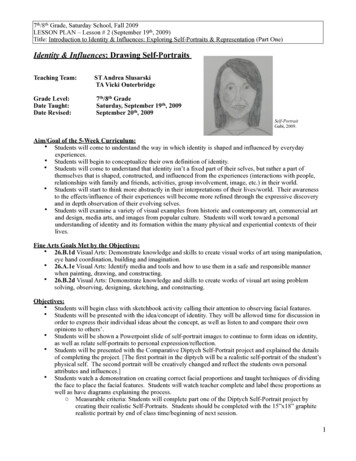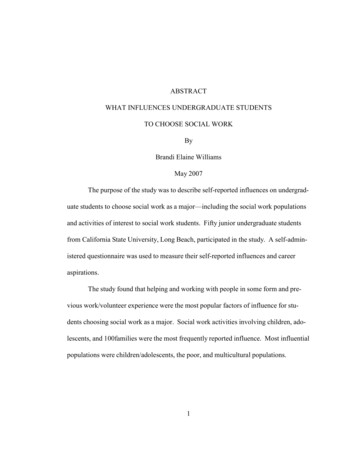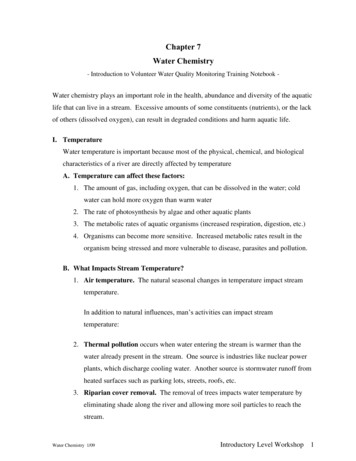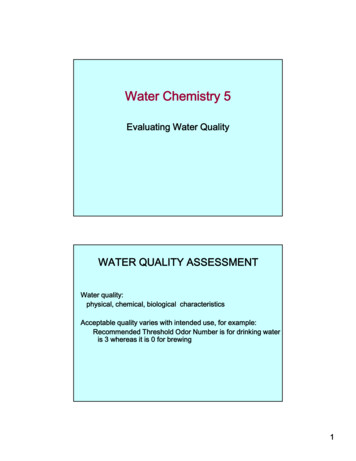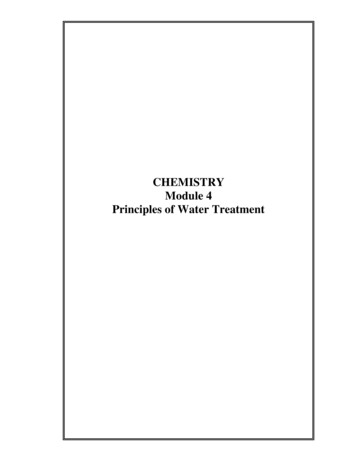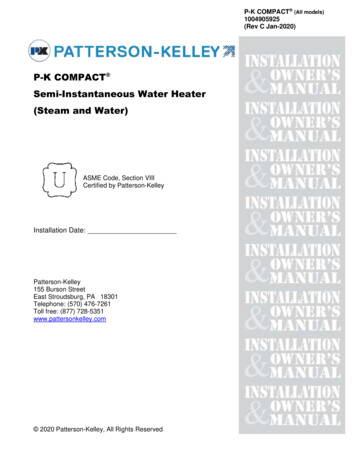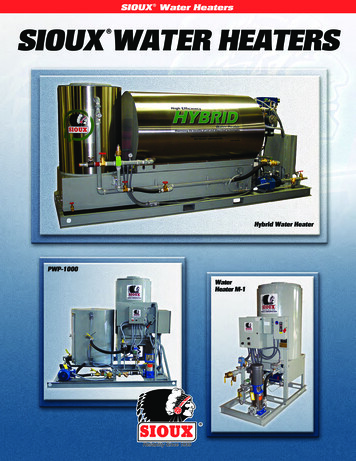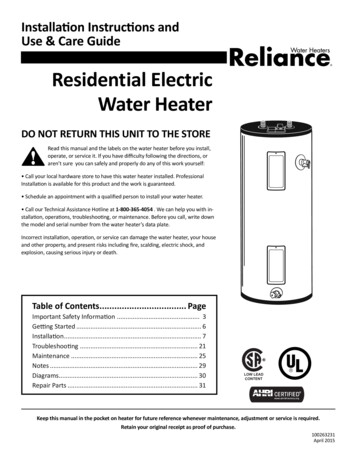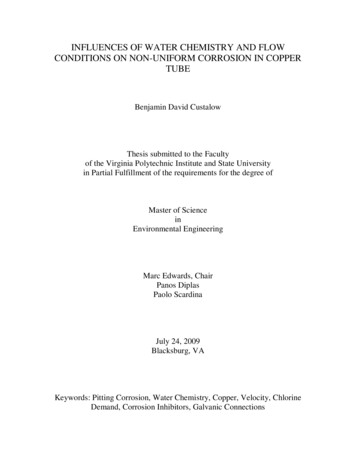
Transcription
INFLUENCES OF WATER CHEMISTRY AND FLOWCONDITIONS ON NON-UNIFORM CORROSION IN COPPERTUBEBenjamin David CustalowThesis submitted to the Facultyof the Virginia Polytechnic Institute and State Universityin Partial Fulfillment of the requirements for the degree ofMaster of ScienceinEnvironmental EngineeringMarc Edwards, ChairPanos DiplasPaolo ScardinaJuly 24, 2009Blacksburg, VAKeywords: Pitting Corrosion, Water Chemistry, Copper, Velocity, ChlorineDemand, Corrosion Inhibitors, Galvanic Connections
Influences of Water Chemistry and Flow Conditions on Non-Uniform Corrosion in CopperTubeBenjamin David CustalowABSTRACTWater chemistry and fluid velocity are factors that can perpetuate certain types of non-uniformpitting corrosion in copper tube, specifically in waters with high chlorine and a high pH. Thesetwo parameters can further act synergistically to alter pitting propensities in copper pipessubjected to this type of water.A preliminary short-term experiment considered pitting propensity in copper pipe as a functionof water chemistry. This study used a water chemistry that had been documented to promote andsustain pitting in copper tube that further developed into fully penetrating pinhole leaks.Modifications to this base water chemistry found that dosing a chloramine disinfect (rather thanfree chlorine) or the addition of silica greatly reduced corrosion activity and pitting propensity oncopper pipes.In another short-term experiment, copper pitting propensity was considered as a function of fluidvelocity. A number of different fluid velocities were tested in several different pipe diametersusing the same documented pitting water. Velocity was observed to significantly increase pittingpropensity in all pipe diameters considered. At the highest fluid velocity tested (11.2 fps) apinhole leak formed in ¼” tubing after only 2 months of testing. Larger pipe diameters were alsofound to increase the likelihood of forming deeper pits on the pipe surface at the same fluidvelocity.Chlorine was a driving factor in corrosion for preliminary tests conducted using this pittingwater. The reduction of chlorine to chloride is believed to be the primary cathodic reactionlimiting the overall rate of corrosion in this type of water. As such, a subsequent studyconsidered the relationship between the rate of chlorine reduction and corresponding corrosionactivity. Chlorine reduction or demand rates were found to be good indicators for pittingpropensity and corrosion activity for this particular type of water.
All preceding work led to the development and design of a large scale, long-term, copper pittingstudy. A matrix of 21 unique conditions tested various water chemistries, flow conditions,corrosion inhibitors, and galvanic connections of copper pipes to other metallic plumbingmaterials. The severity of pitting corrosion was observed to be dramatically decreased by lowerfree chlorine residual concentrations, high alkalinity, and sufficient doses of copper corrosioninhibitors such as natural organic matter, silica, and orthophosphate. Pitting severity wasconsequently observed to increase at a low alkalinity, indicating that this parameter has asignificant effect on corrosion reactions.Furthermore, the addition of aluminum solids to the base pitting water chemistry dramaticallyincreased the formation of tubercle mounds on the inside of the copper pipes in contact with thewaster. Aluminum solids have been observed to be a vital constituent for sustaining pit growthin this specific water at lower pHs, however, the role of this constituent at the high pH levelstested in this study was previously unknown. From simple visual observation, aluminum solidsappear to increase the aggressiveness of this water even at higher pHs.iii
ACKNOWLEDGEMENTSI would first like to thank Dr. Marc Edwards for his assistance in helping me understand andconvey the material herein. His tireless efforts to improve environmental issues involvingcorrosion are remarkable and his steadfast devotion to his research and his students has greatlyinspired me. I would not have been able to produce this work without his encouragement andwise counsel.I would also like to thank Paolo Scardina for providing me with a wealth of knowledge onmatters both theoretical and practical. His wise instruction on plumbing proficiency, his constantavailability for questions, and his willingness to help me with whatever I needed has greatlyassisted me in accomplishing this work.Thanks also to Dr. Panos Diplas for providing me with a fundamental understanding of fluidmechanics and for his encouragement and support of this work.Thanks to the entire Edwards research group for their friendship and camaraderie. I considermyself fortunate to have worked with such an amazing group of people, all of whom havegraciously assisted me in my research and have provided an incredibly supportive environmentfor me.I would like to give special thanks to Emily Sarver for her intelligent insight and advice that hasimproved the quality of this work. This work would not be possible if it weren’t for the vastnumber of hours that she generously spent assisting me in the laboratory and for her willingnessto oversee the final phase of some of the experiments presented herein.I would like to thank my friends and family for their constant support and encouragement. Iwould also like to especially thank my wife, Tara Custalow, for her belief in me that has helpedto give me the strength and resolve that I needed to produce this work.Finally, I would like to thank the Powell Fellowship, the Copper Development Association, andthe Water Research Foundation for their generous funding and support of this work.iv
DEDICATIONThis thesis is dedicated to Dr. G.V. Loganathan and teaching assistant, Matthew Gwaltney, whowere victims in the events that took place on April 16, 2007. By their example, both meninspired me to pursue knowledge and to aid others in the same pursuit. They are the finestteachers that I have ever had.v
ATTRIBUTIONA number of colleagues aided in the research and writing of several chapters of this thesis. Abrief description of their contributions is presented here.Prof. Marc Edwards- Ph.D. (Department of Environmental and Water Resources Engineering,Virginia Tech) is the primary Advisor and Committee Chair. Prof. Edwards established theoverall direction of this research and provided the guidance necessary to complete the differentphases of the experiments presented herein. Furthermore, Prof. Edwards was heavily involved inthe analysis of the experimental data, as well as the writing and presentation of this work.Paolo Scardina- Ph.D. (Department of Environmental and Water Resources Engineering,Virginia Tech) was an advisor in the author’s group. He contributed to the discussion of theelectrochemistry of copper pitting and the discussion on mechanisms by which flow caninfluence pitting reactions in chapter 1. He provided an extensive amount of assistance in boththe construction and maintenance of the experiments presented in all three chapters.Furthermore, he was instrumental in defining the overall structure of this thesis and shaping thefigures presented in this work.Prof. Panos Diplas- Ph.D. (Department of Environmental and Water Resources Engineering,Virginia Tech) was an advisor in the author’s group. He contributed to the discussion on the onthe effects of various flow parameters on pitting propensity in chapter 1. He also helped with thediscussion on the synergistic effects of oxidant availability and delivery rate on pitting reactionsdiscussed in chapter 2.Emily Sarver- M.S. (Department of Environmental and Water Resources Engineering, VirginiaTech) was a student in the author’s group and contributed during her graduate studies to thischapter in terms of developing a method for quantifying the chlorine demand of a pipe networkwhich was used as an indicator of pitting propensity in chapters 2 and 3. She was an incredibleassistance in maintaining the large experiments that make up the bulk of this work. She was alsoinvolved in the conceptualization and design of the water matrix experiment and is overseeingthe continuation of this study.vi
TABLE OF CONTENTSABSTRACT . iiACKNOWLEDGEMENTS. ivDEDICATION . vATTRIBUTION. viTABLE OF CONTENTS .viiLIST OF TABLES . ixLIST OF FIGURES . xAUTHOR’S PREFACE . xiiiCHAPTER 1: INFLUENCE OF WATER QUALITY AND FLUID VELOCITY ON COPPERPITTING CORROSION . 1ABSTRACT. 1INTRODUCTION. 1METHODS AND MATERIALS . 2RESULTS . 8DISCUSSION . 17CONCLUSIONS . 20REFERENCES. 20CHAPTER 2: THE ROLE OF CHLORINE REDUCTION IN COPPER PITTINGCORROSION IN HIGH PH WATERS . 21ABSTRACT. 21INTRODUCTION. 21BACKGROUND. 22vii
METHODS AND MATERIALS . 25RESULTS AND DISCUSSION . 30CONCLUSIONS . 45REFERENCES. 45CHAPTER 3: THE EFFECTS OF WATER QUALITY, FLOW CONDITIONS, CORROSIONINHIBITORS, AND GALVANIC CONNECTIONS ON COPPER PITTING CORROSION . 46ABSTRACT. 46INTRODUCTION. 46METHODS AND MATERIALS . 50RESULTS . 55DISCUSSION . 67CONCLUSIONS . 75REFERENCES. 79APPENDIX A: SUPPLEMENTAL FIGURES . 81viii
LIST OF TABLESTable 1 – 1: Conditions Considered in the Water Quality Study . 3Table 1 – 2: Fluid Parameters Considered in the Flow Study . 5Table 1 – 3: Pit Depths for Different Water Chemistries . 11Table 2 – 1: List of Water Chemistries . 27Table 2 – 2: List of Conditions for Long Term Water Matrix Study . 28Table 2 – 3: Key Findings . 42Table 3 – 1: Pitting Water Recipe . 51Table 3 – 2: List of Test Conditions . 53Table 3 – 3: List of Flow Conditions . 56Table 3 – 4: List of Pinhole Leaks at Seven Months . 71Table 3 – 5: Assessment of All Test Conditions . 75ix
LIST OF FIGURESFigure 1 – 1: Wate
Influences of Water Chemistry and Flow Conditions on Non-Uniform Corrosion in Copper Tube Benjamin David Custalow ABSTRACT Water chemistry and fluid velocity are factors that can perpetuate certain types of non-uniform pitting corrosion in copper tube, specifically in waters with high chlorine and a
